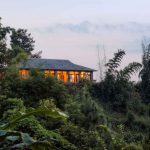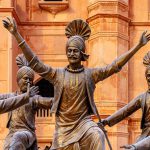Day 1 : Of Curries, Museums and Henna Tattoos

Start in the afternoon from the Lalbaug Spice Market to get an understanding of the spices that go into making the perfect Indian curry. We learn about their origin and observe how these whole spices are bought and roasted in a big wok and crushed into a fine powder, depending on the customer’s blend of choice. Learn about the textile mill culture in the city and how it is umbilical in making Mumbai the populous, the most eclectic metropolis in India today and also get to know some of Mumbai’s food, which owes it’s origin to the mill workers.

Visit Bhaudaji Lad Museum Mumbai’s oldest and arguably, one of the finest contemporary and multi-awarded Museum in the city. Enjoy one of the best views of Mumbai city coming to life from AER, the 34th floor Lounge of Four Seasons Hotel, while sipping cocktails. We end our day with dinner in a local family home to taste the quintessential coastal cuisine of the Malwan region, sandwiched between Mumbai and Goa. Malwani cuisine is dominated by fish. Women here are known for their ability to cook the most delicious fare in a jiffy, including excellent vegetarian dishes. Your host will also introduce you to the traditional Indian art of Henna Tattoo painting, Rangoli use of dry colour design on the floor and Saree Draping, with their significance in Indian homes.
Day 2 : Mumbai at dawn

Start your day at the crack of dawn to understand the logistics of food that come to Mumbai. For breakfast, stop at the famous Mysore Café – famous for its Udupi breakfast from coastal Karnataka which has changed the way India eats breakfast. Udupi breakfast uses ingredients, namely rice in all forms, coconut, pumpkin, bengal gram, lentils, semolina and peas. Dosa, the famous South Indian pancake made from a batter of lentils and rice, served with lentil soup and a chutney, a popular breakfast dish in India. Later visit St. Thomas Cathedral, the first Anglican Church in Mumbai, mix of Byzantine and colonial-era architecture. End with dinner at a local Zoroastrian Restaurant, sampling typical Laganu Bhoonu, an assortment of dishes served at a Zoroastrian wedding, enjoy the Patra ni Machchi (pomfret seasoned with coconut chutney and steamed in banana leaves). Zoroastrianism, the world’s oldest monotheistic religion, was followed by millions in ancient Persia, today having 124,000 adherents worldwide. Mumbai has the largest concentration, about 70,000. The Zoroastrian’s culinary forte may have been their historic undoing; the Arabs who invaded Persepolis in the 10th century realised attacking the warriors after their traditional Sunday lunch of Dhansak was best. The thick mutton stew served with cardamom-scented brown rice is extremely heavy and lulls its eaters into a peaceful siesta afterwards.
Day 3: Marathi food – meat lovers delight

Start your day with a traditional vegetarian breakfast of the Marathi community, known for its meat, fish and fiery non-vegetarian savouries, Marathi food is a meat-lovers delight. But early morning, it has a softer side too, where semolina, chick-pea and rice are used with rich Indian spices, to create wholesome dishes that readies you for a power-packed day ahead. This breakfast, has evolved over the years and the textile mill workers in part, have contributed to it. These workers toiled for over eight hours in the mills, doing exhausting manual labour. In order to consume energy rich food, they ate street food that was high in carbohydrates. We have included some of the mill workers food today in your breakfast. We continue to Bandra, one of Mumbai’s plushest and trendiest suburbs to get acquainted with East Indians Community. Today, though Bandra is the Beverly Hills of Mumbai, there still exist small villages that remind you of the Bandra of yesteryears, which was inhabited by the Portuguese. Take a walk through Ranwar and Pali village and get an insight into the East Indian architecture, history and culture. Meet an East Indian family and understand the changes that Bandra has experienced in recent times. In between our tour, enjoy lunch at a local restaurant where we sample Goan food known for its vast use of rich and diverse seafood, meats and curries along with local ingredients and spices. Goan cuisine is known for its daring yet humble flavours influenced by its Hindu origins and 400 years of Portuguese rule. Meet a Bollywood insider who will share gossip of the Bollywood film industry overs drinks and coffee at the lovely Bandra Bandstand promenade.

Drive to a restaurant in a 5 star hotel for dinner, where the Executive Chef has prepared a special menu combining the flavours of North and South Kerala. North Kerala’s Malabari Muslims and their cuisine is still distinctly influenced by their Arab ancestors who came to trade on their wooden ships making it so very interesting. And as you move inland into South Kerala and its backwaters with its drenched greens and coconut palms, the Syrian Christians, the predecessors of the first Christian converts will tell you that their contribution to the Kerala cuisine has been manifold, the most noted are hoppers, duck roast, meen vevichathu (red fish curry) and the isthew (stew).
Day 4: The Dhobi Ghaat

Start your day by meeting a unique breed of Mumbai, the Laundrymen at the Biggest Open Air Laundry in the World The Dhobi Ghaat. With most of Mumbai’s washing done here, it comes as little surprise that these people can be safely christened as the Washing Machines of Mumbai. We continue to a lesser known gem of Mumbai to spend some time at the Japanese Buddhist Temple; an oasis of peace and quiet.

Later drive to Worli Village for an insight into the life and times of the Kolis; the original inhabitants of Mumbai, its fishermen folk. A walk through this village transports you to the land of stories. What’s fascinating is that nothing has changed since the time of the first settlement be it the way they make their nets, catch their fish, do their business, their beliefs, the custom or age-old traditions.

From Worli Village, we proceed for lunch to sample coastal cuisine from Mangalore region. Incomplete without rice and fish, their distinct flavour is associated with the generous use of kokum, tamarind, curry leaves, coconut and several spices. Start with Sol Kadi; a drink made out of Kokum infused with spices, herbs and garnished with cilantro. Post Lunch, meet your personal shopper, who is a fashion designer for some shopping at the Colaba Causeway, before returning to your hotel.





